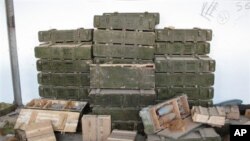For decades, Libyan dictator Moammar Gadhafi stockpiled thousands of Man-Portable-Air-Defense-Systems, or MANPADS. By the time his regime collapsed in October 2011, Libya had accumulated the largest stockpile of MANPADS of any non-MANPAD producing country in the world. The collapse of the regime created a major proliferation challenge for the new Libyan government, the region, and the international community.
Recognizing the risk, the United States took immediate steps to mitigate the proliferation dangers. In April 2011, the U.S. began providing three million dollars in funding to non-governmental organizations that specialize in conventional weapons destruction and stockpile security. They began working with Libya’s Transitional National Council, or TNC, to clear unexploded ordnance and remnants of war and assisted the TNC in securing loose weapons, including MANPADS.
Once the fighting shifted in the TNC’s favor in August 2011, the U.S. immediately deployed a State Department expert from the MANPADS Task Force to the city of Benghazi. The primary objective was to reach an agreement with the TNC to set up a MANPADS control and destruction program. This paved the way for Phase 1 to begin -- an effort to survey, secure and disable loose MANPADS across the country. Thus far, Libyan authorities, supported by U.S. and international technical experts have helped to identify, recover, and secure approximately 5,000 MANPADS and components.
The non-proliferation teams have now completed their initial sweep across Libya, and the effort is entering Phase 2. This involves working with the new Libyan government to conduct a full inventory of all weapons stockpiles and detect and interdict illicit activity. Phase 2 will also help the Libyan government’s efforts to integrate militias and veterans of the fighting.
Once the survey of Libya’s weapons stockpiles has been completed, Phase 3 can begin -- ensuring that Libya’s weapons stockpiles meet modern standards.
This phased approach to countering the proliferation of MANPADS helps create the conditions for a return to stability in the war-torn region. By assisting Libya in removing or securing these destabilizing systems, as well as other deadly remnants of war, the U.S. is helping children, families, and communities live in safety.
Securing Libya's Weapons

For decades, Moammar Gadhafi stockpiled thousands of Man-Portable-Air-Defense-Systems.















